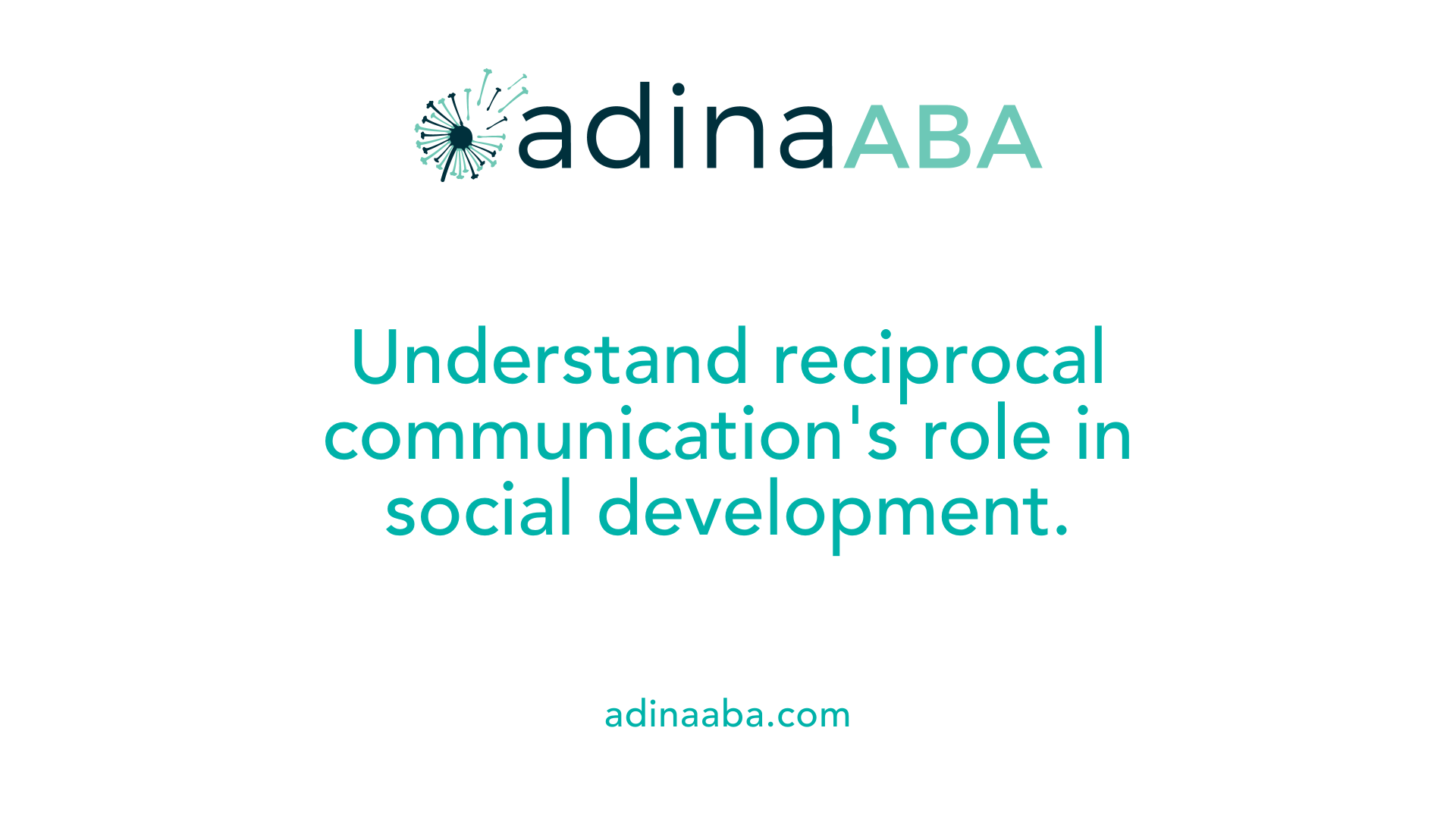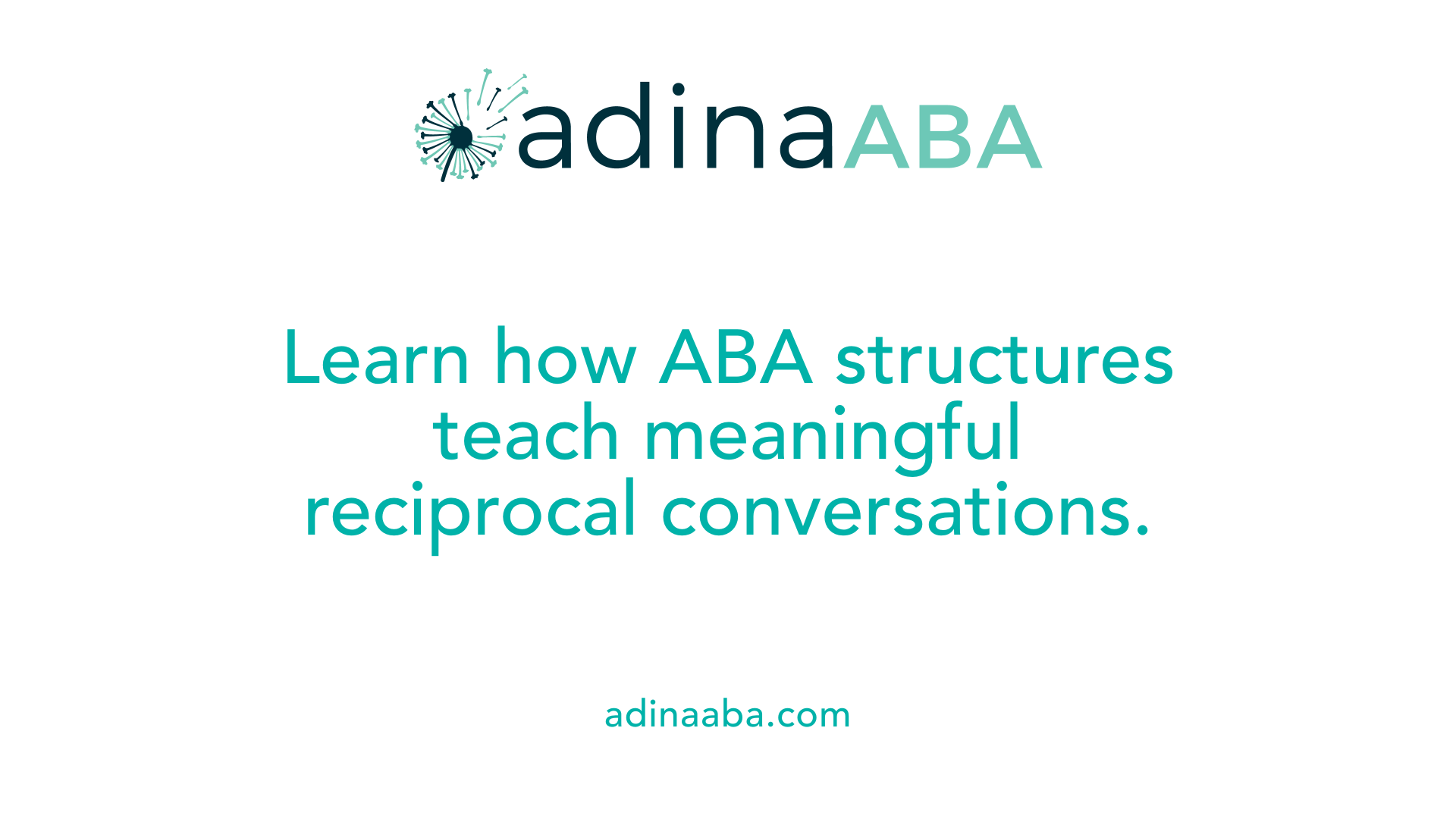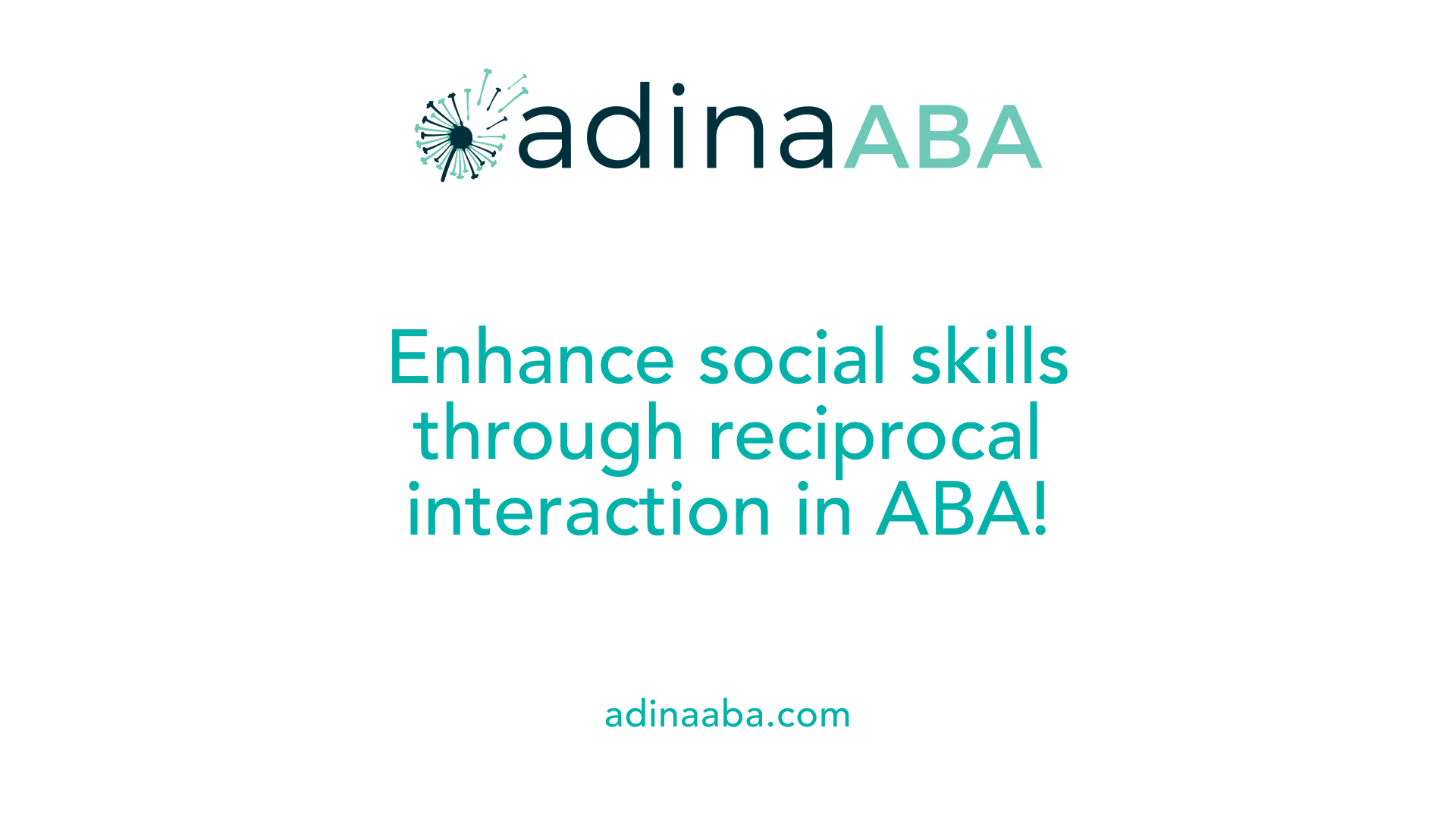Teaching conversational reciprocity through ABA

Understanding Conversational Reciprocity and Its Significance
Teaching conversational reciprocity is crucial for fostering meaningful social interactions in children with autism. Reciprocity refers to the dynamic exchange characteristic of healthy conversations, involving turn-taking, initiating topics, responding appropriately, and maintaining the flow of dialogue. Developing this skill enables children to form stronger connections, express themselves confidently, and navigate social environments more effectively.
Defining Reciprocal Communication and Its Role in Autism

What is reciprocal communication in autism?
Reciprocal communication involves a dynamic back-and-forth exchange where individuals take turns initiating topics, responding, asking questions, and maintaining the flow of conversation. In children with autism, developing these skills is crucial because it helps them engage effectively with others. Therapists often break down conversation into smaller, manageable steps and use visual supports, role-playing, and structured activities to teach children how to initiate and respond appropriately.
Importance of reciprocal communication for social development
Fostering reciprocal conversation skills is vital for broader social development. It enables children to build meaningful connections, improve language use, and gain confidence in social settings. Effective reciprocal communication helps children read social cues, interpret facial expressions, and respond to questions, which are essential components of social inclusion. Through targeted interventions like ABA therapy, children learn to expand their vocabulary, understand social context, and participate actively in conversations. Activities such as role-playing, social stories, and peer interactions support the generalization of these skills in real-world environments, helping children with autism develop stronger social bonds and better emotional regulation.
ABA Therapy as a Framework for Teaching Reciprocity

How ABA teaches reciprocal conversation skills
ABA therapy employs a structured approach to help children with autism develop effective conversational skills. One prominent method involves breaking down complex social behaviors into smaller, manageable steps. This allows children to learn and master each component, such as initiating conversations, taking turns, and responding appropriately.
Role-playing and social scripts are frequently used to simulate real-life interactions and reinforce desired behaviors. These activities provide safe environments for children to practice, make mistakes, and gain confidence. Additionally, ABA uses reinforcement techniques—like praise, tokens, or preferred activities—to motivate children and increase their willingness to engage in reciprocal exchanges.
Heavily data-driven, ABA therapists track progress meticulously, adjusting teaching strategies as needed. This ensures that each child is receiving tailored support to meet their unique needs, leading to gradual improvement in spontaneous, meaningful conversations.
Use of visual supports, reinforcement, data tracking
Visual supports are essential tools in ABA, serving as visual cues that clarify conversational expectations. For example, picture cards or communication boards illustrate turn-taking, questions, and responses, making abstract social concepts more concrete. Visual schedules help structure the flow of conversations and social routines, reducing anxiety and increasing predictability.
Reinforcement strategies remain central to encouraging participation. Praising successful exchanges, providing tangible rewards, or offering access to preferred activities boost motivation. Preference assessments help identify each child's motivation, ensuring reinforcement is meaningful.
Progress tracking via data collection allows therapists to evaluate which techniques are effective. Adjustments can then be made to target specific skills like expanding vocabulary, increasing responsiveness, or initiating conversations. This data-driven approach ensures consistent, measurable improvements in reciprocal communication skills.
Strategies and Activities to Foster Reciprocal Interactions

What are some activities and methods to promote conversational reciprocity in individuals with autism?
Promoting reciprocal conversation skills in individuals with autism involves a variety of structured activities and teaching methods. Turn-taking exercises, such as interactive games and role-playing scenarios, are fundamental in teaching children how to engage in back-and-forth exchanges. These activities help them understand the flow of conversation, including when to speak and listen.
Visual supports are vital tools that make social cues and expectations clearer. Using picture cards, social stories, and communication boards can help children comprehend the structure of conversations and recognize emotional expressions. For example, emotion cards can teach children to interpret facial cues, which enhances their responsiveness during interactions.
Structured social opportunities further reinforce these skills. Group activities, social skills groups, and community-based events provide real-world settings where children can practice turn-taking, sharing, and initiating conversations with peers. These environments also foster confidence and help generalize learned skills outside of therapy sessions.
From an evidence-based perspective, Applied Behavior Analysis (ABA) techniques play a pivotal role. ABA uses positive reinforcement to encourage desired behaviors, such as asking questions or staying on topic, and employs task analysis to break complex skills into manageable steps. Prompting and gradual fading of assistance help children become more independent in their social exchanges.
Incorporating peer interactions and cooperative tasks not only promotes natural conversational skills but also enhances social bonding. Explicit teaching about social cues, emotional awareness, and adjusting responses to others' behaviors further supports meaningful engagement.
In summary, effective strategies include structured turn-taking activities, the use of visual supports, and creating social opportunities that facilitate natural, reciprocal conversations. These methods, supported by ABA principles, are instrumental in helping children with autism develop essential communication skills.
Reciprocal Interaction in ABA and Its Impact on Social Skills

What is reciprocal interaction in ABA, and how does it promote social skills?
Reciprocal interaction in ABA involves engaging children in two-way social exchanges that mimic natural conversations. This includes turn-taking, sharing attention on objects or activities, and imitating actions or sounds. These exchanges are essential for laying the groundwork for social skills.
Through structured activities like role-playing, social stories, and perspective-taking exercises, children learn to respond to social cues such as tone of voice, facial expressions, and emotional signals. These methods help children become more aware of others' feelings and intentions.
Promoting reciprocal interactions encourages children to respond appropriately and initiate conversations. It teaches them how to maintain eye contact, share experiences, and ask questions, making interactions more meaningful and engaging.
By developing these foundational skills, ABA helps children improve emotional recognition, regulation, and expression. Over time, they become better at understanding social contexts, which fosters empathy and deeper relationships.
Ultimately, reciprocal interaction is a core component of ABA’s approach to enhancing social competence. It helps children with autism develop better communication, build friendships, and participate more fully in social settings, improving their overall quality of life.
The Use of Visual Supports and Reinforcements in Teaching Conversation Skills

What are effective strategies to develop reciprocal conversation?
Developing reciprocal conversation skills in children, especially those with autism, involves a combination of structured teaching techniques and supportive tools. Visual supports such as picture cards, social stories, and communication boards help children understand the flow of conversation and social cues. These tools visually depict topics, emotional expressions, and appropriate responses, making abstract social concepts more concrete.
Reinforcement strategies play a crucial role in encouraging desired behaviors during interactions. Praising a child for responding appropriately, using tokens or stickers as tangible rewards, and incorporating preferred activities increase motivation. For example, rewarding a child with a favorite toy or activity after successfully exchanging greetings or asking questions supports ongoing engagement.
Promoting understanding of social cues involves teaching children to recognize facial expressions, body language, and other non-verbal signals. Visual aids like feeling cards or emotion expression images help children associate facial cues with feelings, improving their ability to interpret social situations.
In addition to visual supports and reinforcement, role-playing and modeling social scenarios allow children to practice reciprocal conversation in a safe setting. Supervised social opportunities such as playdates or group activities further reinforce these skills in real-world contexts.
Working with professionals such as speech therapists, psychologists, or social skills specialists can provide individualized strategies tailored to each child's needs. Overall, combining visual supports, reinforcement, and structured practice creates an effective approach for fostering meaningful reciprocal conversations.
Building Confidence and Promoting Generalization in Conversational Skills
Reinforcement plays a vital role in helping children with autism develop confident conversational skills. Positive praise, tangible rewards like tokens, and preferred activities motivate children to practice and improve their communication abilities.
In addition to reinforcement, practicing in natural environments is crucial. Role-playing, social stories, and visual supports help children understand how to use their skills in real-world settings. Activities such as playdates or community events serve as opportunities to generalize learned skills beyond the therapy room.
Caregiver involvement is essential for success. Parents and guardians work closely with therapists to reinforce strategies at home and in everyday situations. Consistent support across different environments ensures that children can apply their skills flexibly and confidently.
How does ABA support the generalization of conversational skills?
ABA therapy emphasizes the importance of transferring communication skills across various settings. By involving parents and caregivers, therapy extends beyond clinical sessions to the home, school, and community. Tools like visual supports, social stories, and structured routines help children recognize cues and expectations daily, making their conversational abilities more natural and effective.
The overall goal is for children to carry their social communication skills into everyday interactions, fostering independence and meaningful connections in a variety of contexts.
| Strategy | Description | Benefit |
|---|---|---|
| Reinforcement | Praise, tokens, preferred activities | Motivates ongoing practice |
| Natural Environment Teaching | Using real-life scenarios for practice | Promotes skill generalization |
| Caregiver Training | Educating parents to support skills outside therapy | Ensures consistency and reinforcement |
| Visual Supports | Picture cards, social stories, communication boards | Clarifies expectations, cues |
| Community Activities | Playdates, group activities | Builds social confidence |
Utilizing these strategies collectively can significantly improve a child's ability to generalize conversational skills, making social interactions more natural and less face-dependent. This holistic approach ultimately helps children with autism participate more fully in everyday life.
Research Evidence Supporting ABA for Developing Conversational Skills
What research supports ABA approaches for conversational skills?
Recent research studies have demonstrated the effectiveness of ABA (Applied Behavior Analysis) in improving reciprocal social conversations among children with autism. One notable study employed a multiple baseline design to examine how a self-management intervention impacted conversation skills.
The study revealed significant improvements in the children’s ability to engage in meaningful, back-and-forth exchanges. Children displayed more elaborate responses, asked relevant questions, and showed greater initiation and maintenance of conversations.
Furthermore, the improvements made during therapy sessions were not limited to the clinical setting. Follow-up measures confirmed that these gains generalized to new conversational partners, demonstrating the ability of children to apply their skills in everyday social situations.
Findings on improvements in reciprocal social conversation
Results indicated that children interacting with trained interventions produced more natural and interesting conversations. They responded appropriately to questions, expanded on topics, and used conversational phrases like "Can I have a turn?" or "What’s your name?"
Self-management techniques within ABA helped children regulate their responses better, turning learning into a more autonomous skill. These behavioral changes contributed to higher quality interactions, increasing their confidence and social participation.
Sustained and generalized treatment effects
Importantly, the study showed that these improvements were not only immediate but sustained over time. Follow-up assessments showed that children maintained their conversational improvements months after therapy concluded.
This evidence supports the idea that conversational difficulties in ASD are often performance issues rather than fixed skill deficits. Through structured ABA methods, children can achieve meaningful, lasting gains in social communication, fostering better connections and inclusion in social environments.
| Study Aspect | Findings | Additional Details |
|---|---|---|
| Research Design | Multiple baseline across participants | Allowed for observation of changes over time |
| Main Outcomes | Enhanced reciprocal conversation, generalized across contexts | Large effect sizes demonstrate strong impact |
| Long-term Effects | Gains maintained and generalized months later | Follow-up data confirmed stability |
| Implications | Supports targeted behavioral interventions for social communication deficits | Emphasizes performance rather than skill gaps |
Harnessing ABA to Foster Social and Conversational Growth
Applying ABA strategies—such as visual supports, structured activities, reinforcement, and caregiver involvement—can significantly improve reciprocal conversation skills in children with autism. These evidence-based approaches help children read social cues, expand their language, and participate more confidently in social exchanges, ultimately enhancing their quality of life and fostering genuine connections.
References
- The Basics of Teaching Reciprocal Conversation in Autism -
- How ABA Therapy Builds the Foundation for Conversation Skills
- What is Reciprocal Play in ABA All About
- Using Self-Management to Improve the Reciprocal Social ...
- Fostering Reciprocal Conversation in Autism Therapy
- Harnessing ABA Therapy for Social Skills Development in Autism
- Focus on Five: Teaching Conversation Skills - The Autism Helper
- How ABA Therapy Helps Improve Social Skills in Children
- Teaching Reciprocal Conversation for Autism - Beyond Care Therapy
More Resources
Expert Clinicians
Get started today ->




.jpg)
.jpg)
